› Forums › Spectroscopy › Nova in M31
- This topic has 17 replies, 6 voices, and was last updated 7 years ago by
 George Carey.
George Carey.
-
AuthorPosts
-
28 November 2018 at 10:37 am #574190
 George CareyParticipant
George CareyParticipantI spotted a new object in M31 on the 26th November. The Liverpool telescope confirmed a nova spectrum for the object, so far designated AT 2018jas. The magnitude is now about 16.4 so would be a good target for amateur spectroscopy.
Coordinates: 00:43:44.560 +41:27:52.40
When first detected the magnitude was 18.5, so it was caught well before the maximum brightness.
This comparison image shows the increase:
Attachments:
28 November 2018 at 11:39 am #580292 Jeremy ShearsParticipant
Jeremy ShearsParticipantCongratulations George: well done for discovering another nova in M31!
28 November 2018 at 10:30 pm #580295 Rob JanuszewskiParticipant
Rob JanuszewskiParticipantWell done George – Yet another discovery in M31.
29 November 2018 at 10:13 am #580297 George CareyParticipant
George CareyParticipantThanks Rob and Jeremy,
Now confirmed as a nova: http://www.astronomerstelegram.org/?read=12245
Remote image from Spain last night gave magnitude 15.6.
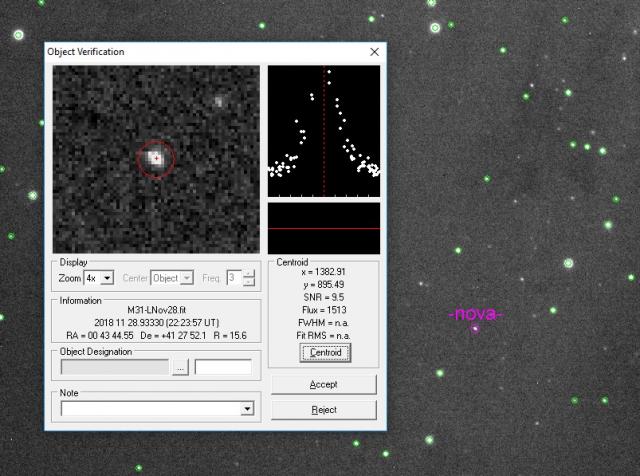 29 November 2018 at 12:21 pm #580298
29 November 2018 at 12:21 pm #580298 Robin LeadbeaterParticipant
Robin LeadbeaterParticipantWent for a spectrum last night with the ALPY 200 but found that a series of power cuts during the storm yesterday had corrupted the observatory computer drive. 15.6 is bright for an M31 nova so definitely worth trying for even with a standard ALPY and novae spectra still show strong emission features later on even when they start to fade in measured brightness.
Robin
30 November 2018 at 2:00 pm #580301 George CareyParticipant
George CareyParticipantRemote images from Spain with poor sky show magnitude on 29th Nov to be 16.3
30 November 2018 at 7:50 pm #580303 George CareyParticipant
George CareyParticipantDifficult to miss tonight.
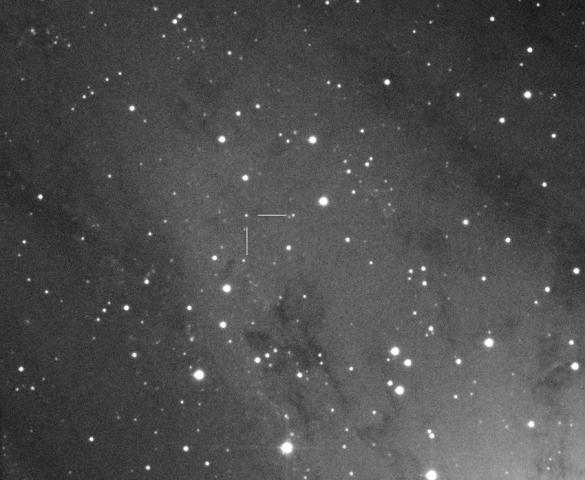 30 November 2018 at 9:33 pm #580304
30 November 2018 at 9:33 pm #580304 Nick JamesParticipant
Nick JamesParticipantGeorge. Congrats on another nice discovery. I’m getting 17.4 unfiltered (UCAC-4 R band) tonight (see attached). I think the photometric apertures that you are using in Astrometrica may be a bit small. This may lead to some problems with it estimating the sky background.
30 November 2018 at 10:00 pm #580305 George CareyParticipant
George CareyParticipantI have the centroid at radius 3.
These are values I get when I change the radius:
centroid magn. radius 1 18.0 2 16.9 3 16.5 4 16.5 5 16.4 6 16.3 7 16.2 8 16.2 At radius 3 it looks like all of the nova is in the circle.
I am never sure what is best.
30 November 2018 at 10:58 pm #580306 Nick JamesParticipant
Nick JamesParticipantAre you using background from PSF or background from aperture? I think you should always use the latter since the PSF background estimator needs a much biffer photometric aperture to work properly. They often give very different magnitude zero points.
30 November 2018 at 11:46 pm #580307 Robin LeadbeaterParticipant
Robin LeadbeaterParticipantHere is a raw spectrum image from tonight (ALPY 600, 6600s total exposure.) It is very faint but the broad H alpha emission is clear. I will try to reduce it to see what else I can pick out
Robin
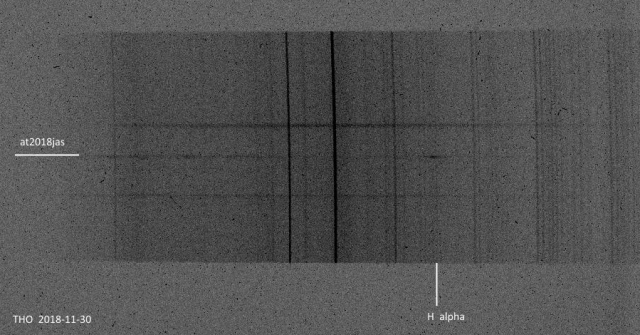 1 December 2018 at 10:24 am #580308
1 December 2018 at 10:24 am #580308 George CareyParticipant
George CareyParticipantI tried Aperture today – very similar results. Mag 16.6.
If I increase the aperture the mag rises to 16.3.
Pinpoint gave fairly consistent values at 16.8
1 December 2018 at 12:11 pm #580302 Dr Paul LeylandParticipant
Dr Paul LeylandParticipantImages from La Palma last night are being analyzed right now but I’m still learning how to do that. Results (possibly preliminary) will be edited into this post. Nova certainly very obvious on the 3000s stacked image but the background from M31 is very bright and precision photometry will need to take that into account.
FWIW, I’m about to download GAIA-DR2 positions and magnitudes for analysis purposes as I don’t have a finder chart and comparison magnitudes. I’m hoping this is satisfactory …
Results are undoubtedly preliminary because I’m still learning how to drive the tool set and much data reduction has been done by hand.. Comparing my V-band mags with GAIA’s G-band gives satisfactory results (less than 0.05 mags at mag 16) so I’m fairly confident that the nova was at mag 16.50 +/- 0.05 at 2018-11-30 02:40UT.
Now to improve my skills and tools.
1 December 2018 at 1:09 pm #580310 George CareyParticipant
George CareyParticipantI put the data from last night into Maxim. Much more involved procedure.
Average value= 17.11
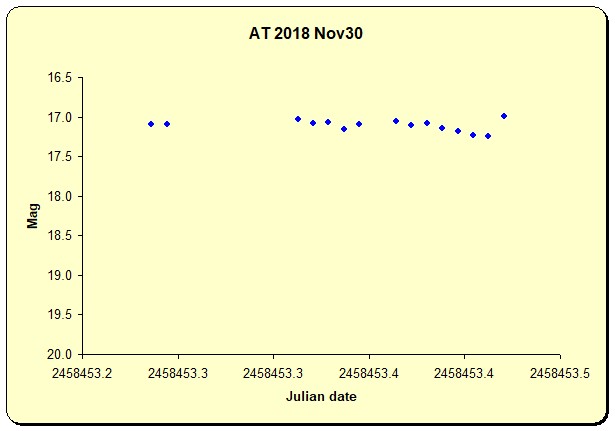 1 December 2018 at 4:42 pm #580311
1 December 2018 at 4:42 pm #580311 Robin LeadbeaterParticipant
Robin LeadbeaterParticipantHere is the reduced spectrum. (red, filtered to R~300 resolution)
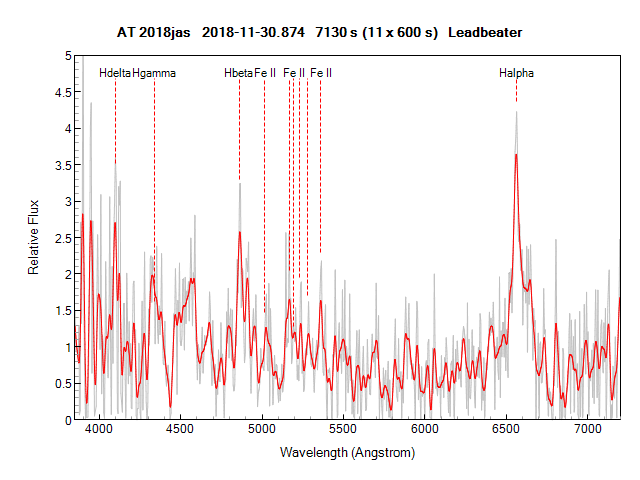
mag ~17 is the faintest target I have attempted with the ALPY600 setup and the SNR is very low. The broad H alpha line is obvious though and other Balmer lines are present too. I have also marked the Fe II curtain lines though they are only marginally detected above the noise.
Cheers
Robin
1 December 2018 at 7:11 pm #580312 George CareyParticipant
George CareyParticipantMost impressive Robin!
13 December 2018 at 11:40 am #580392 George CareyParticipant
George CareyParticipantI have filled in gaps in my data with remote observations using iTelescopes in Spain, and filtered images from Sofia University (Atel #12268).
The nova is now near the limit for my equipment so not much more can be obtained.
13 December 2018 at 12:07 pm #580393 George CareyParticipant
George CareyParticipantAlso photometry from ATLAS_Bot1 and ZTF_AMPEL_MSIP.
-
AuthorPosts
- You must be logged in to reply to this topic.
